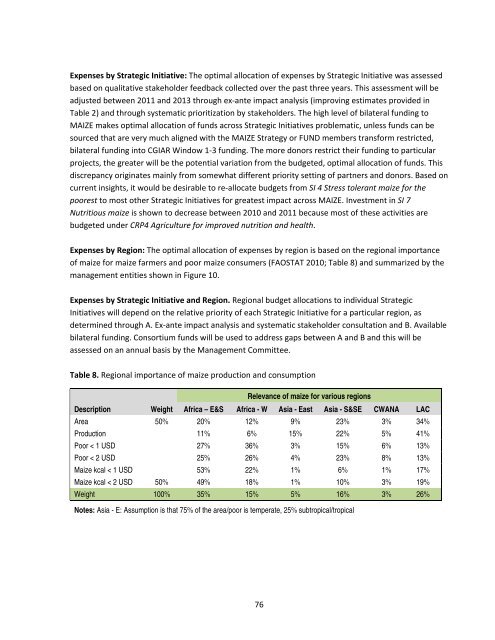Download - Maize
Download - Maize
Download - Maize
You also want an ePaper? Increase the reach of your titles
YUMPU automatically turns print PDFs into web optimized ePapers that Google loves.
Expenses by Strategic Initiative: The optimal allocation of expenses by Strategic Initiative was assessed<br />
based on qualitative stakeholder feedback collected over the past three years. This assessment will be<br />
adjusted between 2011 and 2013 through ex‐ante impact analysis (improving estimates provided in<br />
Table 2) and through systematic prioritization by stakeholders. The high level of bilateral funding to<br />
MAIZE makes optimal allocation of funds across Strategic Initiatives problematic, unless funds can be<br />
sourced that are very much aligned with the MAIZE Strategy or FUND members transform restricted,<br />
bilateral funding into CGIAR Window 1‐3 funding. The more donors restrict their funding to particular<br />
projects, the greater will be the potential variation from the budgeted, optimal allocation of funds. This<br />
discrepancy originates mainly from somewhat different priority setting of partners and donors. Based on<br />
current insights, it would be desirable to re‐allocate budgets from SI 4 Stress tolerant maize for the<br />
poorest to most other Strategic Initiatives for greatest impact across MAIZE. Investment in SI 7<br />
Nutritious maize is shown to decrease between 2010 and 2011 because most of these activities are<br />
budgeted under CRP4 Agriculture for improved nutrition and health.<br />
Expenses by Region: The optimal allocation of expenses by region is based on the regional importance<br />
of maize for maize farmers and poor maize consumers (FAOSTAT 2010; Table 8) and summarized by the<br />
management entities shown in Figure 10.<br />
Expenses by Strategic Initiative and Region. Regional budget allocations to individual Strategic<br />
Initiatives will depend on the relative priority of each Strategic Initiative for a particular region, as<br />
determined through A. Ex‐ante impact analysis and systematic stakeholder consultation and B. Available<br />
bilateral funding. Consortium funds will be used to address gaps between A and B and this will be<br />
assessed on an annual basis by the Management Committee.<br />
Table 8. Regional importance of maize production and consumption<br />
Relevance of maize for various regions<br />
Description Weight Africa – E&S Africa - W Asia - East Asia - S&SE CWANA LAC<br />
Area 50% 20% 12% 9% 23% 3% 34%<br />
Production 11% 6% 15% 22% 5% 41%<br />
Poor < 1 USD 27% 36% 3% 15% 6% 13%<br />
Poor < 2 USD 25% 26% 4% 23% 8% 13%<br />
<strong>Maize</strong> kcal < 1 USD 53% 22% 1% 6% 1% 17%<br />
<strong>Maize</strong> kcal < 2 USD 50% 49% 18% 1% 10% 3% 19%<br />
Weight 100% 35% 15% 5% 16% 3% 26%<br />
Notes: Asia - E: Assumption is that 75% of the area/poor is temperate, 25% subtropical/tropical<br />
76

















